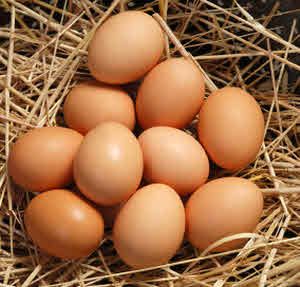Everything you should know about eggs just before Easter
The most expensive egg was bought for $18.5 millionów – it's all about the golden Faberg Eggs, studded with precious stonesé sourced from the car collectionóin the Russian Romanovów. Those real from the hen may not be as expensive, but they are priceless at Easter time – they symbolize new life and are a must-have item at the Easter breakfast.
With Easter approaching „overexposed”… eggs. Do we need to worry about their caloric content? What is the acceptable standard of egg consumption? Why you shouldn't cook them for more than 10 minutes? How to know a stale egg? These and many other questions will be answered in the following article.
Egg under a magnifying glass
Egg protein in almost 90 percent. consists of water, 9 percent. are amino acids, and ok. 1 percent. – carbohydrates. Żóltko w ⅔ are fats – not at all just those „bad”, as accepted. But let's take a closer look.
„Egg is characterized by its cholesterol content – yes, but at the same time it is a source ofódłem of lecithin and a small amount of unsaturated acidóin fatty”, explains Iwonna Niegowska, Knorr brand nutritionist. The World Health Organization (WHO) allows the consumption of eggs in the diet of a healthy person with normalized cholesterol levels as part of a balanced diet. Note that eggs are used for cakes, pastaów, cutletów etc. We can also stick to the principle thatóra mówi that if our diet is not rich in animal fats, while we eat plenty of vegetables and fruitów, then all the more often we can afford an egg.
Why you should eat eggs?
- The egg is the only food product that contains all the essential amino acids, i.e. those thatóhe human body is not able to produce on its own, so it needs to provide itself with food in order to function properly. Two eggs of approx. 60 gramsów each satisfy 35 percent of the. The daily requirement for these amino acids.
- The egg contains a wealth of vitamins and ingredientóin minerals, especially vitamins A, D , B2, as well as well absorbed iron, magnesium, zinc and iodine.
- Lutein contained in the egg benefits vision, and is also a powerful antioxidant.
An egg of weight category L, that is, weighing approx. 65 g in the shell and 56 g without the shell, that's approx. 7 gramsóIn protein and 90 calories.
Handle like an egg – chef's tips
And here is some practical advice for all those whoóers love eggs, from Knorr chef Piotr Murawski:
- We should absolutely store eggs in the iceówce. If they are in a humid and warm room, the bacteria on the shell can penetrate inside.
- We should not store eggs in iceówce longer than 3 weeks, as there is a gradual breakdown of proteins and vitamins and rancidity of fat – a natural aging process. Also consider that eggs absorb odors from ice creamóin the refrigerator.
- Before use, the egg should be washed in warm water, while if eaten raw, it should be scalded. This is extremely important, because if it happens that the laying hen is infected with bacteria, this action can protect us from transmitting the disease to our body. However, eggs should not be washed before putting them in the refrigeratorówki, because we wash in this wayób protective layer from the shell.
- Eggs are acidotwórcze, therefore, to preserve the zróIn a balanced diet, remember the presence of alkaline foods in itów, e.g. vegetables and groats.
- How to tell if an egg is fresh? After breaking the ¿ólt should be firm and round, while the white should be thick (it should not spill).
- If you are wondering – better cut or raw ¿óltko – it's worth knowing that under both forms it is digestible to the same extent. Protein, on the other hand, is different – it should not be eaten raw, because there is an ingredient present in protein thatóry blocks the absorption of vitamin B7, or biotin.
- Finally, the good news – Eggs, as one of the few productsów, can be safely fried in butter, as the protein is already congealed at 60 degrees, so even before the butter starts to burn and produce toxic compounds.
Egg „with the tag”
And a few more wordsóin, whichóre will indicateówką when making a purchaseów. Eggs on store póThe coots, like clothes on hangers, usually come in four sizes S, M, L and XL. Instead of a centimeterów counts here weight. Eggs marked with a size S are small eggs, whichóre weigh less than 53 grams, M are in the range 53-63 grams, L are large eggs weighing 63-73 grams, while the XL size gets the handsome eggs weighing more than 73 grams.
We can classify eggs not only by weight category, but róAlso the breeding system, or in practice the type of rearing.
Zwrómoth the digit from whichórej begins the code located on the egg:
- 0 are eggs from organic production. This means that the hens are raised outdoors, with access to free range, and on top of that the hens were fed a feed certified organic.
- 1 is free-range eggs – This means that the hen has access to an enclosure and lives in free range conditions.
- 2 are eggs from wall rearingóof the henhouse – the hen is raised in limited conditions, but can walk freely around the henhouse, has access to sand and perches. EU regulations specify that the number of animals per square meter of floor space is 9 laying hens.
- 3 these are eggs from cage farming, which is the least friendly. Hens do not have the ability to move freely because they are constantly in cages.
And finally, a sample code from the egg and its decryption:
1/EN/9 16 12 03
1 denotes the breeding system discussed above, EN is the indication of the country of origin, the following followed by 4 numbers are, in order: wództwa, county code, range code and farm code. As you can see, the origin of no egg will remain anonymous!



